Archives
An additional difference in ACC between H
An additional difference in ACC-1 between H. contortus and C. elegans is the results from the oocyte expression experiments. Here we found that unlike Cel-ACC-1 that was reported to form a functional homomeric channel (Putrenko et al., 2005), Hco-ACC-1 does not. However, we have observed that in general the hco-acc genes do not express in oocytes as readily as other cys-loop receptors we have examined in our laboratory. However, co-expression of Hco-ACC-1 and 2 yielded a channel 3x more sensitive to ACh (EC50 5.9 μM) compared to the Hco-ACC-2 homomeric channel. Differences in sensitivities between nematode homomeric and heteromeric Peptide 17 have also been observed in the UNC-49 GABA receptor (Bamber et al., 1999; Siddiqui et al., 2010) and the GluCl (Cully et al., 1994). Interestingly, we have found that changing loop B phenylalanine to a tyrosine in Hco-ACC-2 produced a hypersensitive channel with an EC50 of 2.9 μM (Habibi et al., 2018). In Hco-ACC-1 there is a naturally occurring tyrosine (Y178) at the analogous position which may partially explain why the ACC-1/2 heteromeric channel was more sensitive to ACh compared to the ACC-2 homomeric channel. The significance of this naturally occurring tyrosine in Hco-ACC-1 to the in vivo function of the receptor is unknown. Moreover, we are still uncertain whether Hco-ACC-1 requires co-expression with additional subunits in vivo and while we have found that ACC-1 can co-express with ACC-2 in oocytes we have been unsuccessful, thus far, in determining the tissue location of ACC-2. Thus, we do not know at this time whether Hco-ACC-1 and 2 assemble to form a functional channel in vivo. The oocyte experiments merely suggest that the assembly of ACC-1 and ACC-2 is possible.
Examination of the Hco-ACC-1 binding site using in silico modelling has also highlighted some unique features of this receptor family. Aside from the fact that ACCs are not present in mammals, they also appear to have a unique agonist binding site. The most striking difference between Hco-ACC-1 and both alpha and non-alpha nAChRs is absence of the signature cys-cys motif in binding loop C (see Fig. 1a). Second, the tryptophan residue that has been shown in nAChRs to contribute to a pi-cationic interaction with the quaternary amine of acetylcholine (and carbachol) is still present in ACC-1, but is located in loop C (W225) rather than in the traditional loop B seen in nicotinic receptors and the AChBP (Beene et al., 2002; Celie et al., 2004). Recently, we have shown that this loop C tryptophan is crucial for receptor function in the Hco-ACC-2 receptor (Habibi et al., 2018). Interestingly, a similar shifting of this key tryptophan residue from loop B to C is also seen when we compare serotonin 5-HT3 and nematode MOD-1 receptors (Mu et al., 2003). A loop C tryptophan is also present in tyramine and dopamine-gated chloride channels (Beech et al., 2013), suggesting that it may be important for the ability of nematode cys-loop receptors to respond to a diverse array of molecules. However, it is important to note that the binding site for ACh on the Hco-ACC-1/2 channel could also be on the interface of two ACC-1 or ACC-2 subunits (Habibi et al., 2018) or an ACC-2/1 heterodimer. Further research will be important to determine the subunit stoichiometry and variation in binding-sites of the ACC family of receptors.
While traditionally characterized as a muscarinic receptor agonist used primarily for the treatment of glaucoma, we have shown that carbachol (carbamylcholine) is an effective agonist at the nematode ACC-1/2 receptor with an EC50 about 2-fold higher than acetylcholine. Carbachol is also an agonist for muscle nicotinic receptors but with an EC50 over 10 -fold higher compared to acetycholine (Akk and Auerbach, 1999). Perhaps the structural differences between nAChRs and ACC receptors as outlined above can explain the relatively high sensitivity of  carbachol observed in our study. Nevertheless, it is clear that further study of the molecular pharmacology of ACC receptors can provide an excellent opportunity for the study of current AChR agonists and the possible discovery of novel agonists.
carbachol observed in our study. Nevertheless, it is clear that further study of the molecular pharmacology of ACC receptors can provide an excellent opportunity for the study of current AChR agonists and the possible discovery of novel agonists.